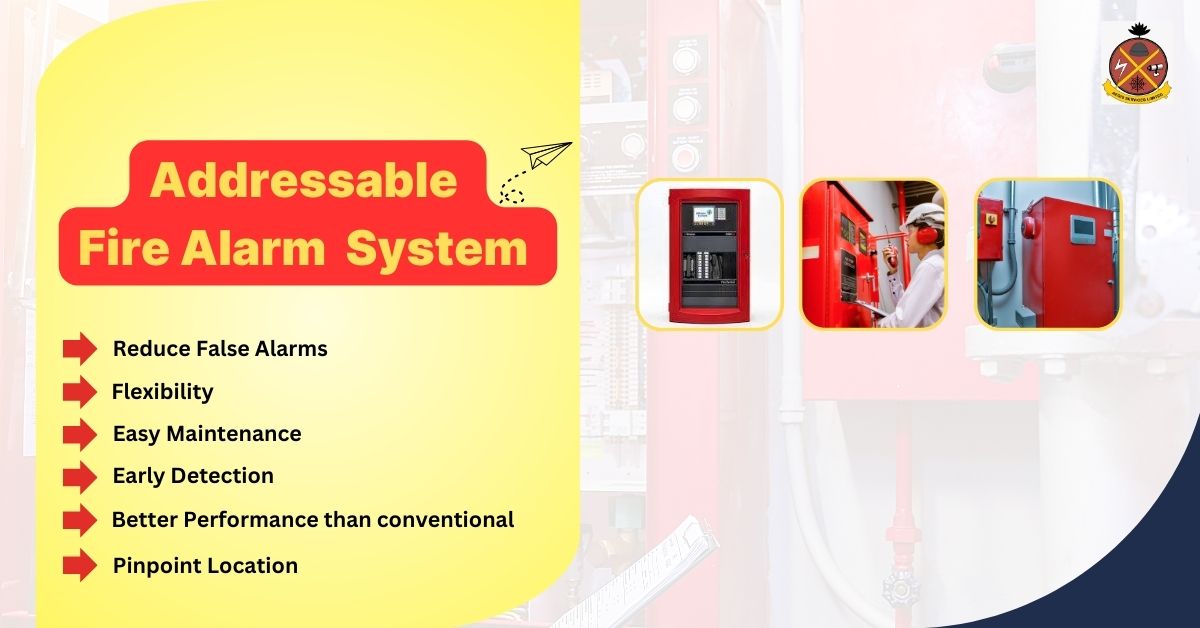Do you know an Addressable Fire Alarm System prevents from false alarm? Before thinking to install this system, you need to get complete knowledge about the functions and addressable fire alarm system definition.
If you own or manage a building, it’s essential to understand the benefits of this type of system and how it can help keep your property and its occupants safe in the event of a fire. In this blog post, we’ll explore the definition of an Addressable Fire Alarm System, its key benefits, and how it works to detect fires quickly and accurately.
Addressable Fire Alarm System Definition
A question arises what is addressable fire alarm system? At first, it is one of the fire protection and detection equipments. A type of warning warning system that can pinpoint the exact location of a fire or smoke within a building. In this system, each device, such as a smoke detector or a heat detector, is assigned a specific address that the main control panel can identify. When a device detects smoke or heat, it sends a signal to the main control panel, which can then display the exact location of the device that has been triggered.
How Addressable Fire Alarm System Works?
The Fire Alarm System uses interconnected devices, including smoke detectors, heat detectors, and control panels. When a device detects smoke or heat, it sends a signal to the main control panel, which can then display the exact location of the device that has been triggered. From there, the system can activate alarms, communicate with emergency services, and inform building occupants about what to do during a fire.
Key Benefits of an Addressable Fire Alarm System
There are several key benefits of an Addressable Fire Alarm System, including:
- Early Detection: Addressable Fire Alarm Systems can detect fires early, which can help minimize damage and reduce the risk of injury or loss of life.
- Pinpoint Location: These systems can pinpoint the exact location of a fire, allowing for a more efficient and targeted response.
- Easy Maintenance: Addressable systems can be easier to maintain than conventional ones, as they often identify which specific devices require attention.
- Better Performance: These systems can perform better than conventional systems, as they can often detect fires more quickly and accurately.
- Flexibility: Addressable systems can be more flexible than conventional systems, as they can be easily reconfigured or expanded to accommodate changes in a building’s layout or occupancy.
- Reduce False Alarm: Sometimes accumulations of dust and grime can set off an alarm. As, the alert system is inter connected. The possibility is less to show unnecesary emergency alarms.
- Remotely work: You can monitor, maintain and operate at a distance.
- Voice based: It can be combined with other voice alarm system and public address solutions.
- Video based : For reliability and fastness fire detection in dare environments.
Fire Alarm System Components
An Addressable Fire Alarm System consists of several key components, including:
- Control Panel: Addressable fire alarm system control panel is the main component, which receives signals from the devices and activates alarms and notifications.
- Smoke Detectors: These devices detect smoke and send signals to the control panel when smoke is present.
- Heat Detectors: These devices detect heat and send signals to the control panel when high temperatures are detected.
- Notification Devices: These include alarms, strobe lights, and other devices that alert building occupants to the presence of a fire.
Fire Alarm System Installation and Maintenance
A qualified professional should perform the installation and maintenance of an Addressable Fire Alarm System to ensure that the system is installed correctly and functioning properly. Regular maintenance and testing of the system can ensure it is working correctly and identify any issues before they become significant problems.
Fire Alarm Systems integration with other building systems
An Addressable Fire Alarm System can be integrated with other building systems, such as HVAC, Emergency Communication Systems, Building Automation Systems, Elevator Systems or Security, to comprehensively respond to emergencies. Building owners and managers can improve safety and security by integrating these systems while streamlining operations.
As a trusted partner of BOSCH, we are the reliable supplier of BOSCH Fire Alarm Systems in Bangladesh. Here are some ways that Addressable Fire Alarm Systems can integrate with other building systems:
- HVAC Systems: An intelligent Fire Alarm System can integrate with HVAC systems to control airflow during a fire. The system can automatically shut down air handling units in the affected area to prevent the spread of smoke and flames.
- Security Systems: Integration capability with security systems to monitor and control access to areas of the building during emergencies keeps ahead from conventional systems. For example, the system can automatically lock or unlock doors to prevent people from entering or leaving certain areas.
- Elevator Systems: An Addressable Fire Alarm System can integrate with elevator systems to control the movement of elevators during emergencies. The system can automatically send elevators to designated floors to help evacuate occupants or prevent people from accessing certain areas.
- Building Automation Systems: An Addressable Fire Alarm System can integrate with building automation systems to provide a more coordinated response to emergencies. For example, the system can automatically turn off lights and close blinds in the affected area to prevent the spread of smoke and flames.
- Emergency Communication Systems: An Addressable Fire Alarm System can integrate with emergency communication systems to provide clear and concise instructions to building occupants during emergencies. The system can automatically activate speakers and display messages to guide people to safety.
By integrating Addressable Fire Alarm Systems with other building systems, building owners and managers can improve safety and security while reducing the risk of damage and loss of life during emergencies. However, it is important to work with qualified professionals to ensure that the systems are installed and integrated correctly.
Addressable Fire Alarm System vs. Conventional Fire Alarm System
While both Addressable and Conventional Fire Alarm Systems are designed to detect fires and alert building occupants, there are some critical differences between the two types of systems. Addressable systems can provide more detailed information about the location of a fire, while conventional systems can be less expensive to install in smaller buildings.
Addressable Fire Alarm System Codes and Standards
Several codes and standards apply to Addressable Fire Alarm Systems, including those set forth by the National Fire Protection Association (NFPA). These codes and standards ensure that the system is installed correctly and functioning properly to help keep building occupants safe.
Wrapping Up:
An Addressable Fire Alarm System is essential to any building’s fire safety system. By providing early detection and pinpointing the location of fires, these systems can help minimize damage and reduce the risk of injury or loss of life. If you’re considering installing an Addressable Fire Alarm System in your building, work with a qualified professional to ensure the system is installed correctly and appropriately.








Leave A Comment